SORGHUM DISEASE- SYMPTOMS & CONTROL
In this blog we will know the important disease of sorghum (Jowar).
Head Smut: Sphacelotheca reiliana
Symptom
- The fungal spores live in the soil and germinate in the spring.
- The entire ear head is completely or partially replaced by a large whitish gall.
- Spores move with wind and water to the soil and serve as inoculum for the next year.
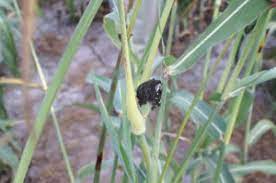
Management
- The best practice is to grow resistant cultivars.
- Seed treatment with Vitavax @ 2g/kg of seed.
- Collect infected ear heads in cloth bags and dip in boiling water to remove inoculum.
Covered Kernel Smut: Sphacelotheca sorghi
Symptoms
- Head replaced by brown, powdery mass of fungal spores covered by gray to brown membrane; entire head may be affected or fungus may be localized at the top, bottom or sides of the head.
- Ratoon crops exhibit a higher disease incidence.
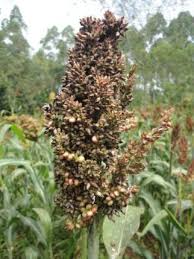
Management
- Same as head smut.
- Avoid rationing
Long Smut: Tolyposporium ehrenbergii
Symptom
- Relatively small proportion of the florets is infected.
- The spore (sori) sacs are cylindrical, elongate, usually slightly curved with a relatively thick creamy-brown covering membrane.
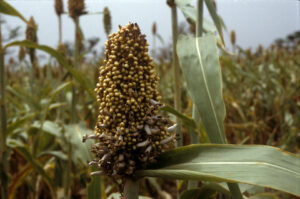
Management
- Same as covered smut.
Loose smut: Sphacelotheca cruenta
Symptom
- The ears come out much earlier than the healthy. The affected plants are shorter than the healthy plants with thinner stalks and marked tillering.
- Ear head gives a loose appearance than healthy. The sorus is covered by a thin membrane which ruptures very early, exposing the spores even as the head emerges from the sheath.
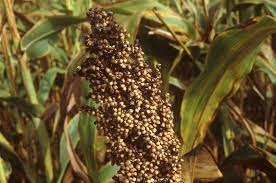
Management
- Seed treatment with Carboxin (Vitavax) @ 2g/kg seed or Captan/Thiram 4g/kg of seed.
- Collect smutted earheads in cloth bags and destroy by dipping in boiling water.
- Avoid rationing.
Downy Mildew: Peronosclerospora sorghi
Symptoms
- Downy mildew spores germinate and invade the roots of sorghum seedlings.
- Infected seedlings may become chlorotic and die. Infected plants are usually sterile.
- Abundant downy white growth is produced nocturnally on the under surfaces of infected portions of leaves during humid weather.
- Favourable Conditions– Maximum sporulation takes place at 100% relative humidity; optimum temperature for sporulation is 21-23˚C during night while light drizzling accompanied by cool weather is highly favourable.
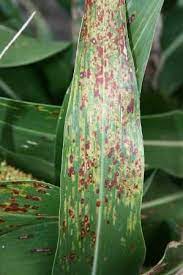
Management
- Rogue infected plants up to 45 days of sowing.
- Spray fungicides like Metalaxyl + Mancozeb 500 g or Mancozeb 1000g/ha after noticing the symptoms of foliar diseases.
Rust: Puccinia purpurea
Symptom
- The pustules are elliptical and parallel with the leaf veins.
- In highly susceptible cultivars the pustules occur so densely that almost the entire leaf tissue is destroyed.
- Favourable Conditions are low temperature of 10 to 12˚C favours teliospore germination, while spell of rainy weather favours the onset of the disease.
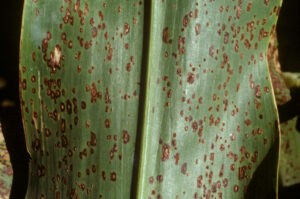
Management
- Spray Mancozeb at 1kg/ha. Repeat fungicidal application after 10 days.
Anthracnose and Red Rot: Colletotrichum graminicola
Symptom
- Based on site where damage occurs, categorize into leaf anthracnose, panicle (grain) anthracnose, and anthracnose stalk rot. Lesions begin on the lower leaves and progress up the plant.
- Oval to elongate water soaked lesions may develop close together and coalesce to kill large portions of the leaf.
- Mid-rib infection often occurs and is seen as elongate-elliptical red or purple lesions on which the black acervuli can be clearly seen.
- Infected stems when split open show discoloration which may be continuous over a large area, or more marbled appearance.
- Favourable Conditions are ontinuous rain, temperature of 28-30˚C and high humidity.
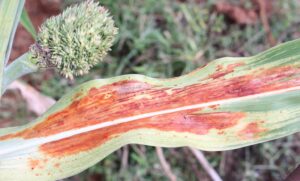
Management
- Seed treatment with Captan or Thiram @ 4g/kg of seed.
- Spray with Mancozeb 1 kg/ha.
Ergot or Sugary disease- Sphacelia sorghi
Symptoms
- The disease is confined to individual spikelets.
- The first symptom is the secretion of honey dew from infected florets. Under favourable conditions, long, straight or curved, cream to light brown, hard sclerotia develop. Often the honey dew is colonised by Crerebella sorghivulgaris which gives the head a blackened appearance.
- A period of high rainfall and high humidity during flowering season and cool night temperature and cloudy weather favours the disease.
Management
- Adjust the date of sowing so that the crop does not flower during September-October when high rainfall and high humidity favor the disease.
- Spray Mancozeb 2 kg/ha or Carbendazim at 500 g/ha at emergence of ear head (5-10 per cent flowering stage) followed by a spray at 50% flowering and repeat the spray after a week, if necessary.
Cereal Grain Molds: A complex of several fungal species
Symptom
- The most commonly isolated Fusarium species are semitectumand F. moniliforme. The grain infected with these fungi develops a fluffy white or pinkish coloration.
- Curvularia lunata is also frequently encountered and this fungus colors the grains black.
Management
- Spray Mancozeb 1 kg/ha or Captan 1kg + Aureofungisol 100g/ha.
See also…
SUGARCANE DISEASES- SYMPTOMS & CONTROL
MAIZE DISEASES- SYMPTOMS & CONTROL
WHEAT DISEASE- SYMPTOMS & CONTROL
RICE DISEASE- SYMPTOMS & MANAGEMENT